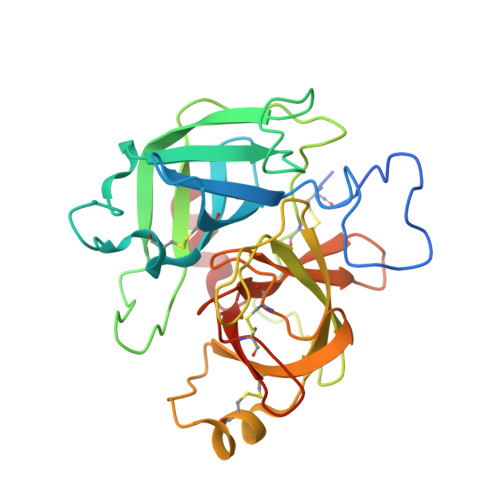Blocking the proteolytic activity of zymogen matriptase with antibody-based inhibitors.
Tamberg, T., Hong, Z., De Schepper, D., Skovbjerg, S., Dupont, D.M., Vitved, L., Schar, C.R., Skjoedt, K., Vogel, L.K., Jensen, J.K.(2019) J Biol Chem 294: 314-326
- PubMed: 30409910
- DOI: https://doi.org/10.1074/jbc.RA118.004126
- Primary Citation of Related Structures:
5LYO - PubMed Abstract:
Matriptase is a member of the type-II transmembrane serine protease (TTSP) family and plays a crucial role in the development and maintenance of epithelial tissues. As all chymotrypsin-like serine proteases, matriptase is synthesized as a zymogen (proform), requiring a cleavage event for full activity. Recent studies suggest that the zymogen of matriptase possesses enough catalytic activity to not only facilitate autoactivation, but also carry out its in vivo functions, which include activating several proteolytic and signaling cascades. Inhibition of zymogen matriptase may therefore be a highly effective approach for limiting matriptase activity. To this end, here we sought to characterize the catalytic activity of human zymogen matriptase and to develop mAb inhibitors against this enzyme form. Using a mutated variant of matriptase in which the serine protease domain is locked in the zymogen conformation, we confirmed that the zymogen form of human matriptase has catalytic activity. Moreover, the crystal structure of the catalytic domain of zymogen matriptase was solved to 2.5 Å resolution to characterize specific antibody-based matriptase inhibitors and to further structure-based studies. Finally, we describe the first antibody-based competitive inhibitors that target both the zymogen and activated forms of matriptase. We propose that these antibodies provide a more efficient way to regulate matriptase activity by targeting the protease both before and after its activation and may be of value for both research and preclinical applications.
Organizational Affiliation:
Department of Molecular Biology and Genetics, Danish-Chinese Centre for Proteases and Cancer, Aarhus University, Gustav Wieds Vej 10C, Aarhus 8000, Denmark.















